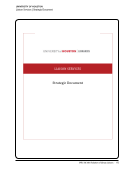SPEC Kit 349: Evolution of Library Liaisons · 93
Increased familiarity with library service in the academic departments. Increased awareness of academic department
needs in the libraries. Integration of the library in the academic life of the university.
Increased perceived value of libraries/librarians to faculty. Support for teaching and research efforts. Improved library
understanding of departments’ needs.
Increased student success. Increased research productivity. Increased national recognition.
Informed collections/content building. Better awareness of Libraries resources and information literacy/research skills.
Improved research outcomes (higher quality papers/assignments, etc.)
Integral role in health sciences center, now key component of health sciences center planning. Participation in curriculum
development and research design. Library has much higher profile with users, esp. faculty and administrators.
Integrates the library and its expertise into the professional curricula of the Health Sciences Center. Develops close
professional relationships among liaisons and faculty/administrators from the Health Science Center, building
collaborations to strategically plan, collaborate on projects and grants, understand and meet the priorities of the HSC.
Proactively brings students into the library and provides them with the sense that it is their “home away from home”.
Involvement with faculty and student research. Liaisons are included in developing teaching and learning strategies and
objectives. Library is seen as a partner in institutional mission and programs.
Keeps the Libraries relevant. Establishing good relationships with patrons. Helps create effective collection strategies.
Knowledge of the changing needs of academic departments and programs. Spreading awareness of library services and
support. Connections with liaison librarians at other institutions covering same subject areas.
Learning about the current priorities in schools and academic departments. The creation of partnerships with faculty
that are intellectually stimulating and have impact on teaching, research, and learning on campus. Students are better
researchers and ultimately better-informed citizens resulting from research sessions and consultations.
Librarians are essential partners in teaching and research, raising recognition of the library’s value. Librarians have
opportunities to increase knowledge in areas of interest to users (e.g., copyright, OA, data management). The library
learns about user needs and preferences through liaisons’ interactions with users.
Library is aware of what is happening within the department. Partnerships. Customization.
Making connections and building relationships with faculty in other departments. Opportunity to promote library
services. Insight into collection and service needs of departments.
Meeting constituent needs. Improved partnerships. Increased visibility of the library.
More pro-active involvement with university departments and student interactions. Greater visibility for library across
campus. Use of professional time for strategic goals.
Provide research assistance to faculty and students. Provide instruction to faculty and students to more effectively use
library resources and services. Develop collections to support scholarship and research.
Provides a way to bring current resources and services directly to faculty and students. Brings information about
research/teaching/data/resource needs within department back to the libraries. Gathers information we need to
determine future direction of the library.
Provides one knowledgeable point of contact for faculty and students. Promotes library resources and services.
Increased familiarity with library service in the academic departments. Increased awareness of academic department
needs in the libraries. Integration of the library in the academic life of the university.
Increased perceived value of libraries/librarians to faculty. Support for teaching and research efforts. Improved library
understanding of departments’ needs.
Increased student success. Increased research productivity. Increased national recognition.
Informed collections/content building. Better awareness of Libraries resources and information literacy/research skills.
Improved research outcomes (higher quality papers/assignments, etc.)
Integral role in health sciences center, now key component of health sciences center planning. Participation in curriculum
development and research design. Library has much higher profile with users, esp. faculty and administrators.
Integrates the library and its expertise into the professional curricula of the Health Sciences Center. Develops close
professional relationships among liaisons and faculty/administrators from the Health Science Center, building
collaborations to strategically plan, collaborate on projects and grants, understand and meet the priorities of the HSC.
Proactively brings students into the library and provides them with the sense that it is their “home away from home”.
Involvement with faculty and student research. Liaisons are included in developing teaching and learning strategies and
objectives. Library is seen as a partner in institutional mission and programs.
Keeps the Libraries relevant. Establishing good relationships with patrons. Helps create effective collection strategies.
Knowledge of the changing needs of academic departments and programs. Spreading awareness of library services and
support. Connections with liaison librarians at other institutions covering same subject areas.
Learning about the current priorities in schools and academic departments. The creation of partnerships with faculty
that are intellectually stimulating and have impact on teaching, research, and learning on campus. Students are better
researchers and ultimately better-informed citizens resulting from research sessions and consultations.
Librarians are essential partners in teaching and research, raising recognition of the library’s value. Librarians have
opportunities to increase knowledge in areas of interest to users (e.g., copyright, OA, data management). The library
learns about user needs and preferences through liaisons’ interactions with users.
Library is aware of what is happening within the department. Partnerships. Customization.
Making connections and building relationships with faculty in other departments. Opportunity to promote library
services. Insight into collection and service needs of departments.
Meeting constituent needs. Improved partnerships. Increased visibility of the library.
More pro-active involvement with university departments and student interactions. Greater visibility for library across
campus. Use of professional time for strategic goals.
Provide research assistance to faculty and students. Provide instruction to faculty and students to more effectively use
library resources and services. Develop collections to support scholarship and research.
Provides a way to bring current resources and services directly to faculty and students. Brings information about
research/teaching/data/resource needs within department back to the libraries. Gathers information we need to
determine future direction of the library.
Provides one knowledgeable point of contact for faculty and students. Promotes library resources and services.












































































































































































































